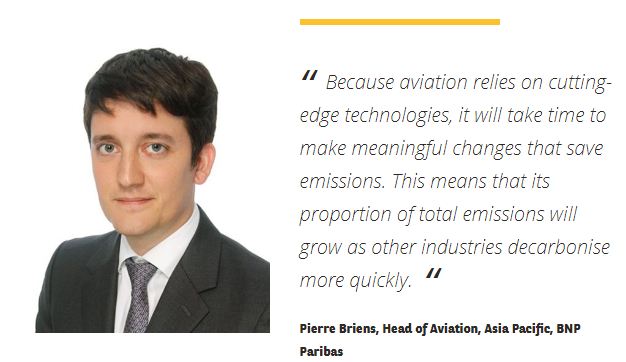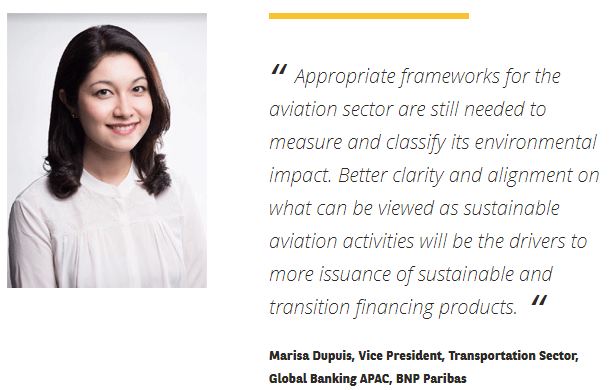The pandemic has forced a reset for the global aviation industry. Can it also be a chance to plot a new course toward net-zero?
Now, as economies look to return to some degree of normality, and with pressure mounting for all industries to transition towards net-zero emissions by 2050, in line with the Paris Agreement, can aviation rebuild on a more sustainable basis?
Before the pandemic, the aviation sector was responsible for an estimated 2% of global CO2 emissions in 2019, according to the Air Transport Action Group. But this small percentage is deceptive: aviation is a ‘hard-to-abate’ sector.

“Because aviation relies on cutting-edge technologies, it will take time to make meaningful changes that save emissions,” explained Pierre Briens, Head of Aviation, Asia Pacific at BNP Paribas. “This means that its proportion of total emissions will grow as other industries decarbonise more quickly. The industry’s goal is therefore to keep its share of total emissions at worst at the same level as the whole shrinks – until they are emitting 2% of zero,” said Briens.
Practical solutions
Airlines have long understood the business case for more efficient aircraft: jet fuel is their largest running cost, so reducing consumption increases profitability. To this end, research and development has focused on creating aircraft and deployment strategies that minimise fuel consumption.
“From better aerodynamics to new, lighter materials and less thirsty engines, modern aircraft represent the culmination of years of focus on efficiency,” explained Briens. “And what reduces fuel consumption also reduces emissions.”
Airlines are working hard to cut unnecessary consumption, including by optimising their routes, reducing taxi time on the ground, and even taxiing on one engine. “Another theoretical solution is to fly less: Covid-19 has shown how fewer flights can reduce emissions,” said Briens. “But this is counterintuitive for a business which services a real demand.”
The long-term solution is to transition to cleaner fuels. Some promising technologies have emerged that offer a route to decarbonisation, but this will be a long-haul journey that requires the participation of the entire supply chain.
“Biofuels or Sustainable Aviation Fuel (SAF) as well as hydrogen powered engines have potential but still face technical and logistical hurdles, which mean they are about 10 to 15 years away from large-scale deployment,” said Briens. “And hydrogen, for example, could work for narrow-bodied aircraft carrying up to 200 passengers. But it does not appear a viable option for wide-bodied long-haul aircraft.” Similarly, electric engines could work for smaller civil aviation models but are not yet scalable to their larger counterparts.
Crunching the numbers
Because aviation’s emissions are regarded as hard-to-abate and the industry remains heavily reliant on fossil fuels, the most appropriate funding solution for now would be transition financing – bespoke loans or bonds that allow corporates to embark on ambitious decarbonisation initiatives that may not yet fulfil the precise criteria for green bonds or loans.

“It’s very early days –so far green and sustainable-linked financings in the sector have been mostly for adjacent assets like green buildings, hangars, and social projects sponsored by airlines or for R&D fuel research,” said Briens.
Marisa Dupuis, Vice President, Transportation Sector, Global Banking APAC at BNP Paribas, added: “While there has been some discussions at the European Commission level on the inclusion of aviation in the EU Taxonomy, appropriate frameworks for the sector are still needed to measure and classify its environmental impact. Better clarity and alignment on what can be viewed as sustainable aviation activities will be the drivers to more issuance of sustainable and transition financing products.”
Work is well under way to fill the data gap.
“The gross environmental impact of a single flight is quite easy to measure – it’s a function of distance, passenger density and aircraft type used,” said Briens. “But the net impact – as measured against taking other available options such as a train – is more complex. Aircraft manufacturers are putting a lot of resources into this, and there are third-party service providers who can provide some of the data.”
Embedding sustainability key performance indicators to financing can be a powerful tool for airlines to engage with the financing community and measure progress towards their net-zero goal.
“The airlines are on top of what they can achieve operationally, so we focus on advising and encouraging them how to report their emissions thoroughly and accurately,” said Briens. “We guide them how to set ambitious goals and update them continually – this builds greater transparency.”
Early steps
In the meantime, many airlines offer their passengers the opportunity to offset their flights’ emissions by paying a small extra fee. Several territories have established mechanisms that enable the airlines to purchase voluntary carbon certificates which can be traded with lower-emitting counterparties.
Carbon credits offsets are important, but they are a stopover on a long journey towards a low-carbon future for aviation, noted Briens. As borders reopen, all parties need to recognise that decarbonisation initiatives for the aviation industry are not a quick fix.
“Some environmentalists argue that carbon offsets do not really incentivise behaviour change and instead create moral hazard, whereby polluters feel justified in their activities because they are able to pay a fee,” commented Dupuis.
Additionally, it can be difficult for the average person to navigate the carbon offset world and find reputable projects towards which to direct their money. In most developed countries, there is no meaningful regulation over carbon offsets purchased by individual consumers.
“We need to take a measured approach in assisting our clients to make real progress,” added Briens. “We are encouraging clients to adopt meaningful solutions that will make a difference over time, rather than resorting to measures that win short-term accolades.”
This is the key difference between carbon neutrality, using offsets, and transitioning to net-zero by truly tackling greenhouse gas emissions across the sector’s operations and supply chain.

